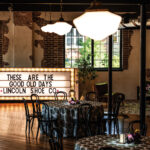Costumes are the ultimate party ice-breaker, allowing even the most introverted to adopt an intriguing identity. And what’s a better opening line than, “Wow, you make a great …?”
The savvy folks of Lititz have been surfing the rising costume-party wave for several years. Beginning with a “Great Gatsby” party in 2013, Venture Lititz, the organization responsible for the town’s economic vitality, hosted a sold-out fundraiser that was embraced by Lititz residents who arrived all dolled up as fringed flappers and dashing tuxedo-clad gents. The formula was set: Lititz loves a party, and Lititz loves to dress for the role.
Last October’s event, “Lititz Goes to Hollywood,” brought out the silver screen’s glamour-puss archetypes like Marilyn Monroe and Audrey Hepburn, as well as some unconventional icons like Captain Jack Sparrow and Star Trek’s Jean-Luc Picard. A red carpet led from South Broad Street’s sidewalk into a former church, now renovated into a stylish social venue by Lititz residents Skip and Roy Clair. The site was generously donated as the Tinsel Town-themed party space. Above the heads of 250 guests, a video streamed iconic scenes from well-known movies over the decades – from Butch Cassidy and the Sundance Kid’s last stand to Bugs Bunny outwitting Elmer J. Fudd. Live music rocked the house with an over-flowing dance floor, as Frankenstein and his Bride, Pulp Fiction’s versions of Uma Thurman and John Travolta, and other pillars of the Lititz community in disguise partied the night away, all for the continued vibrancy of one of America’s coolest small towns.
As the major force behind ensuring Lititz remains and grows as an attractive environment for people, investment and commerce, Venture Lititz has come up with a new reason to dress up and party down. Slated for Saturday, October 17, “The Fabulous 50s” will be celebrated, and you can bet that party goers will show up to twist and shout in their spiffiest saddle shoes and bobby socks, poodle skirts, white t-shirts and black leather jackets.




















